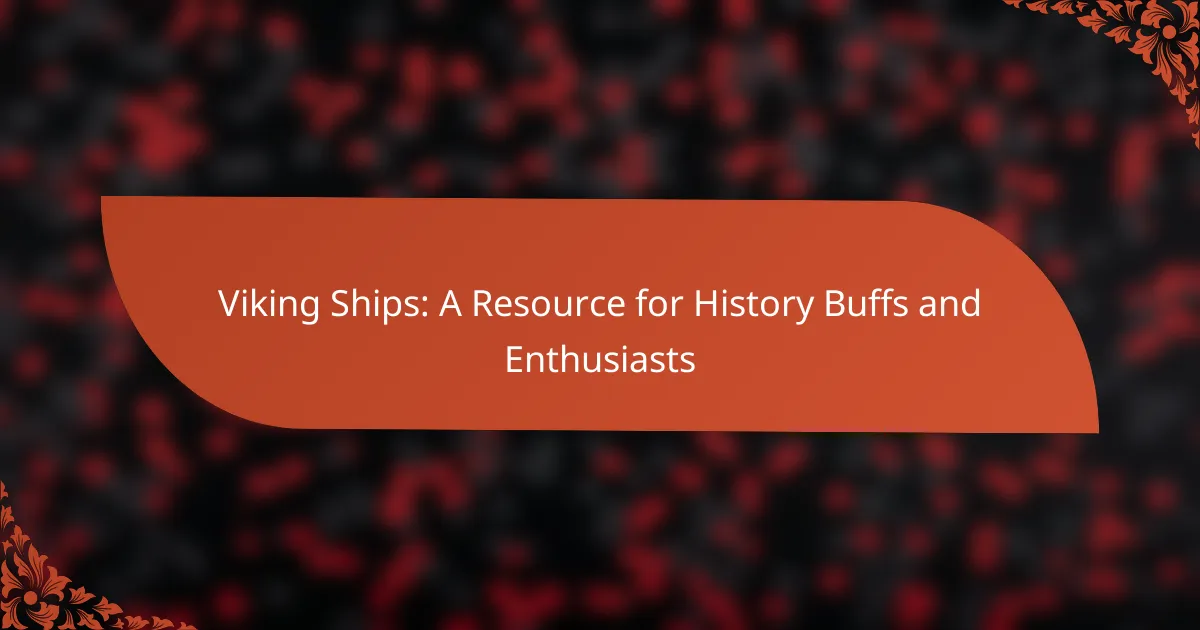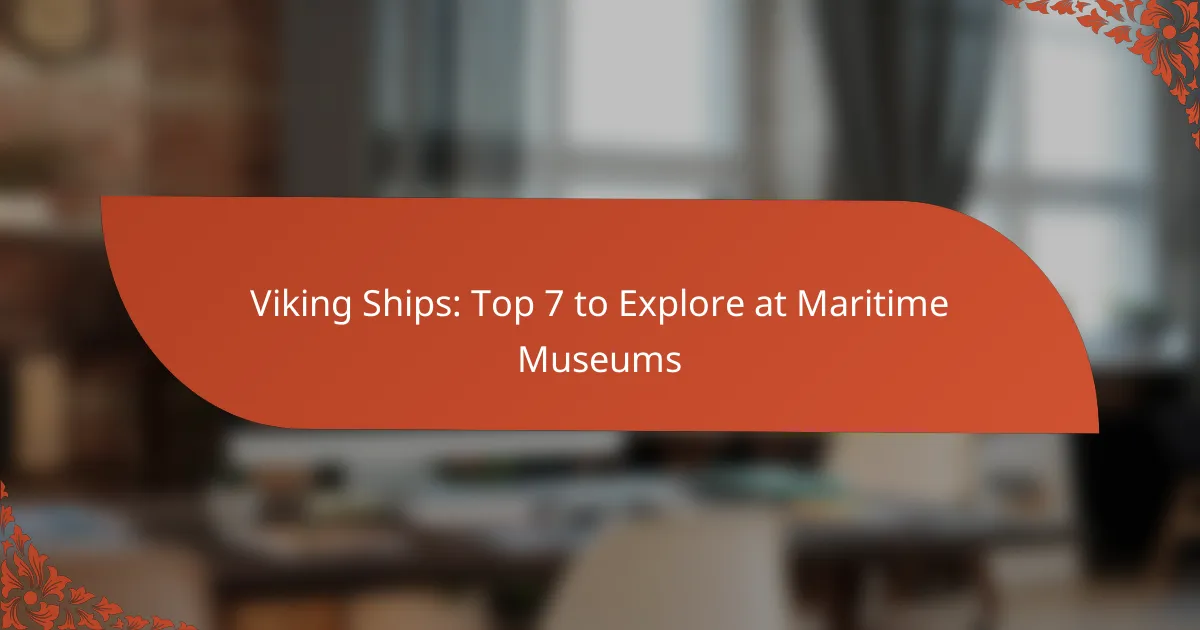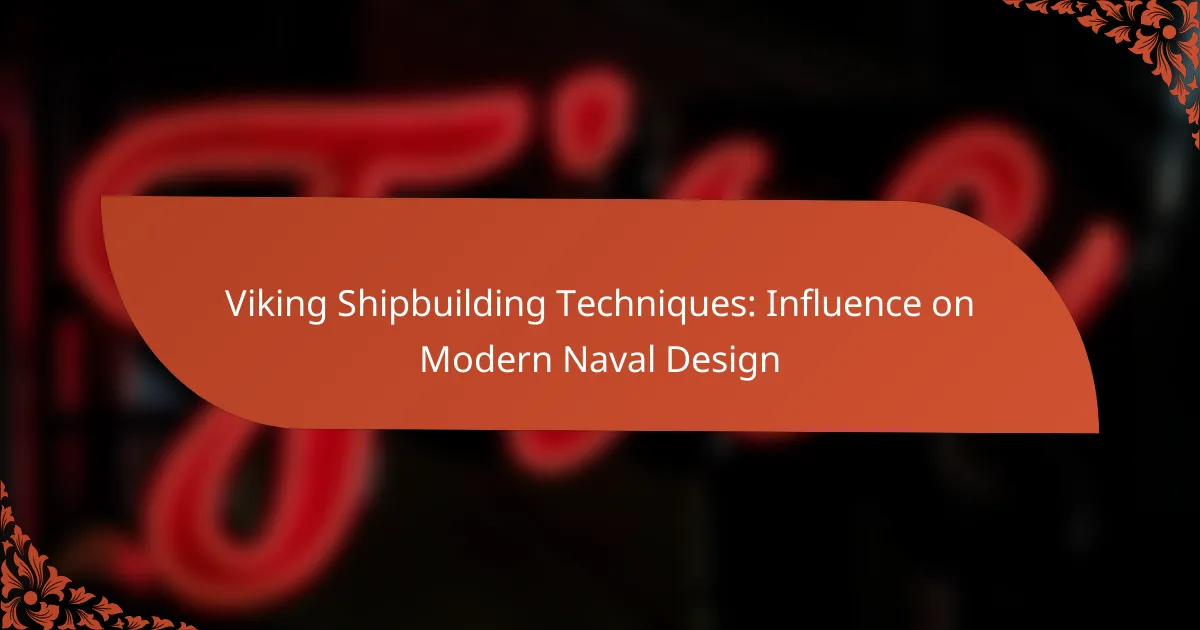Viking ships are a fascinating subject for history buffs and enthusiasts, known for their remarkable design and versatility that enabled navigation in both open seas and shallow rivers. With a long, narrow hull and a single mast featuring a square sail, these vessels were engineered for speed and agility. For those interested in historical reenactments, selecting an authentic replica is crucial, taking into account factors like size and budget. Across Europe, particularly in Norway, Denmark, and Sweden, numerous replicas are available for viewing in museums or for purchase online.

How to choose a Viking ship for historical reenactments
Choosing a Viking ship for historical reenactments involves considering authenticity, size, and budget. It’s essential to select a vessel that accurately represents the era while meeting your specific needs for performance and display.
Types of Viking ships
There are primarily two types of Viking ships: longships and knarrs. Longships were designed for speed and agility, making them ideal for raiding and warfare, while knarrs were broader and used for cargo transport. Understanding the purpose of your reenactment will help determine which type best suits your needs.
Longships typically feature a shallow draft, allowing them to navigate both open seas and shallow rivers. Knarrs, on the other hand, have a deeper hull, providing better stability for carrying goods over long distances.
Materials used in construction
Traditional Viking ships were constructed primarily from oak, known for its durability and strength. Other woods, such as pine and birch, were also used for specific parts like the deck and interior. When selecting a replica, ensure that the materials reflect historical accuracy.
Modern replicas may incorporate fiberglass or other materials for ease of maintenance and cost-effectiveness. However, these may not provide the same authentic experience as wooden ships.
Size and capacity considerations
The size of a Viking ship can vary significantly, with longships ranging from about 15 to 30 meters in length. Capacity is also a crucial factor; a longship can typically carry around 20 to 60 warriors, while a knarr can transport several tons of cargo. Assess the number of participants in your reenactment to choose an appropriately sized vessel.
Consider the space available for storage and transport of the ship. Larger ships may require more logistical planning, including transportation and setup at the reenactment site.
Cost factors for replicas
The cost of Viking ship replicas can vary widely based on materials, size, and craftsmanship. Basic replicas may start in the low thousands of USD, while high-quality, historically accurate models can reach tens of thousands. Budget accordingly, factoring in not just the purchase price but also maintenance and storage costs.
When sourcing a replica, consider whether to buy from specialized builders or to construct one yourself. DIY projects can save money but require significant time and skill. Always compare options to find the best balance between authenticity and budget.

Where to find Viking ship replicas in Europe
Viking ship replicas can be found across various locations in Europe, particularly in countries with a rich Viking history such as Norway, Denmark, and Sweden. These replicas are often displayed in museums, featured in reenactment events, or available through online marketplaces.
Major museums with Viking ship exhibits
Several prominent museums in Europe showcase Viking ship exhibits, offering visitors a chance to see these remarkable vessels up close. The Viking Ship Museum in Oslo, Norway, is renowned for its well-preserved ships, including the Oseberg and Gokstad ships. Similarly, the National Museum of Denmark in Copenhagen features an impressive collection of Viking artifacts and ship models.
In addition, the Roskilde Viking Ship Museum in Denmark is dedicated to the preservation and reconstruction of Viking ships, providing insights into their construction and use. These museums often host special exhibitions and educational programs, making them valuable resources for history enthusiasts.
Reenactment groups and events
Reenactment groups across Europe frequently organize events that feature Viking ship replicas, allowing participants to experience Viking life firsthand. Events such as the annual Viking Festival in York, England, and the Viking Market in Lofotr, Norway, often include ship displays and demonstrations of sailing techniques.
Joining a local reenactment group can provide opportunities to participate in sailing and maintaining replicas, as well as attending various historical events. These groups often welcome newcomers and provide training in traditional skills, enhancing the immersive experience.
Online marketplaces for replicas
For those interested in purchasing Viking ship replicas, several online marketplaces specialize in historical models. Websites like Etsy and eBay feature a range of handcrafted and commercially produced replicas, catering to different budgets and preferences.
When buying online, consider the size and material of the replica, as well as the seller’s reputation. Reading reviews and checking return policies can help ensure a satisfactory purchase. Additionally, some specialized retailers focus on high-quality replicas that may come with detailed historical context, making them ideal for collectors and enthusiasts alike.

What are the key features of Viking ships
Viking ships are renowned for their unique design and versatility, which allowed them to navigate both open seas and shallow rivers. Key features include a long, narrow hull, a shallow draft, and a single mast with a square sail, enabling speed and agility in various waters.
Longship design and functionality
The longship is a symbol of Viking maritime prowess, characterized by its elongated shape and shallow draft, which allowed for beach landings and navigation in rivers. Typically ranging from 20 to 30 meters in length, these ships were built with overlapping planks, providing strength and flexibility against the harsh sea conditions.
Functionally, longships were designed for speed and maneuverability, making them ideal for raiding and exploration. The ability to row or sail, combined with a lightweight structure, enabled quick travel across different terrains, from coastal waters to inland rivers.
Drakkar vs. Knarr distinctions
Drakkars and knarrs represent two distinct types of Viking ships, each serving different purposes. Drakkars, often referred to as dragon ships, were longships used primarily for warfare and raiding, featuring a shallow draft and a sleek design for speed. They typically had a single mast and could carry around 20 oarsmen.
In contrast, knarrs were broader and sturdier, designed for cargo transport and long voyages. With a deeper hull and a larger cargo capacity, knarrs could hold significant amounts of goods, making them essential for trade. While drakkars emphasized speed and agility, knarrs prioritized stability and storage, reflecting the diverse needs of Viking society.

What is the history of Viking ships
Viking ships have a rich history that dates back to the late 8th century, playing a crucial role in the seafaring culture of the Norse people. These vessels were designed for speed, agility, and versatility, enabling the Vikings to explore, trade, and raid across vast distances.
Origins and evolution
The origins of Viking ships can be traced to the early Norse societies, where they evolved from simple wooden boats to more complex designs. The iconic longship, characterized by its long, narrow hull and symmetrical ends, emerged around the 9th century, allowing for both oceanic voyages and river navigation.
Over time, Viking shipbuilding techniques advanced, incorporating features such as clinker-built construction, which involved overlapping planks, and the use of sails for enhanced speed. These innovations made Viking ships some of the most advanced maritime vessels of their time.
Significance in Viking culture
Viking ships were not just modes of transportation; they were integral to the social and economic fabric of Norse culture. They facilitated trade routes that connected Scandinavia to Europe, the Middle East, and beyond, fostering cultural exchanges and economic prosperity.
Moreover, ships held symbolic importance in Viking society, often being used in burial rites for prominent figures. The grandeur of a ship burial reflected the deceased’s status and ensured their safe passage to the afterlife, illustrating the deep connection between Viking ships and their cultural identity.

How to maintain a Viking ship replica
Maintaining a Viking ship replica involves regular inspections, proper storage, and appropriate repairs to ensure its longevity and historical accuracy. Key aspects include protecting the wood from moisture and pests, along with routine maintenance tasks to keep the vessel seaworthy.
Best practices for preservation
To preserve a Viking ship replica, it is crucial to keep it in a controlled environment, ideally indoors or under a protective cover when not in use. Regularly check for signs of rot or insect damage, and treat any affected areas promptly with appropriate preservatives.
Using breathable materials for coverings can help prevent moisture buildup, which is essential for wooden structures. Additionally, applying a protective finish, such as a marine-grade varnish, can enhance durability against the elements.
Common repairs and upkeep
Common repairs for Viking ship replicas often include replacing damaged planks or caulking seams to prevent leaks. Regularly inspect the hull for cracks or signs of wear, and address these issues before they escalate.
Routine upkeep should also involve cleaning the ship with gentle soap and water to remove dirt and salt buildup. Schedule maintenance checks at least once a season, especially before and after sailing, to ensure all components are in good condition.

What are the cultural impacts of Viking ships today
Viking ships continue to influence modern culture through their design, symbolism, and representation in media. Their historical significance as vessels of exploration and trade resonates in contemporary maritime practices and cultural narratives.
Influence on Modern Shipbuilding
The design principles of Viking ships have inspired modern shipbuilding, particularly in creating vessels that prioritize speed and efficiency. Their long, narrow hulls and shallow drafts allow for swift navigation in various water conditions, which are concepts still valued in contemporary yacht and boat design.
Many shipbuilders study Viking ship construction techniques, such as clinker building, where overlapping planks create a lightweight yet strong structure. This method is sometimes adapted in modern boat designs for specific applications, emphasizing durability and performance.
Cultural Symbolism
Viking ships symbolize exploration, adventure, and resilience, often representing a connection to heritage for Scandinavian countries. They are featured in national emblems, festivals, and educational programs, reinforcing a sense of identity and pride among communities.
In popular culture, Viking ships appear in films, television series, and literature, shaping perceptions of the Viking Age. Their portrayal often emphasizes themes of bravery and discovery, contributing to a romanticized view of Norse history.
Tourism and Education
Viking ships attract tourists to historical sites and museums, enhancing cultural education and awareness. Many countries, particularly in Scandinavia, host exhibitions showcasing reconstructed Viking ships, which provide insights into maritime history and craftsmanship.
Educational programs centered around Viking ships often include hands-on experiences, such as sailing replicas, which engage participants and deepen their understanding of Viking culture. These initiatives promote historical literacy and appreciation for maritime heritage.









